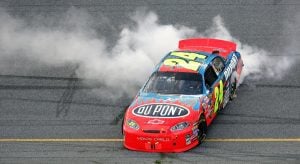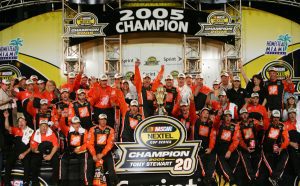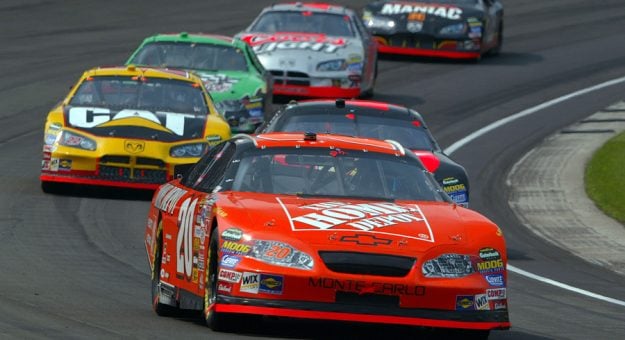Editor’s Note: NASCAR is celebrating its 75th anniversary. SPEED SPORT was founded in 1934 and was already on its way to becoming America’s Motorsports Authority when NASCAR was formed. As a result, we will bring you Part 58 of a 75-part series on the history NASCAR.
Few American sports cover as much ground — or last nearly as long — as the NASCAR Nextel Cup season. It begins a few days after Valentine’s Day in February and ends just before families gather to enjoy Thanksgiving in November.
From the time Jeff Gordon drove to an overtime victory to win the season-opening Daytona 500 for the third time to Tony Stewart’s impressive drive to the championship, it was a season to celebrate.
It was a chance to see tremendous new stars develop, such as Carl Edwards — winner of four races in his first full season — and 20-year-old Kyle Busch, a talented rookie who won twice in the second half of the year.
It was also a time to say goodbye to two of NASCAR’s greatest drivers, as Rusty Wallace and Ricky Rudd concluded their outstanding careers.
There were many memorable moments, beginning with Gordon taking the checkered flag in the dusk at Daytona — a race that was extended three laps because of a late caution. It was Gordon’s 70th victory.

Stewart was already one of the best drivers before he clinched the Nextel Cup with a 15th-place finish in the final race Nov. 20 at Homestead-Miami Speedway.
By winning the title in NASCAR’s premier series for the second time in four years, Stewart’s legacy has gained even more stature.
He became the 14th different driver to win multiple Nextel Cup championships.
“Tony Stewart, in my eyes, is the greatest race car driver I’ve watched drive in this era,” Mark Martin said. “A.J. Foyt might have been that when I was a little boy, but Tony Stewart is my driving hero.”
Consider that Stewart was the first driver to win all three United States Auto Club national championships in the same season (1995). He won the Indy Racing League title in 1997, switched to NASCAR and established a then record three victories in a season for a Cup rookie in 1999, and won the 2002 series championship.
Stewart’s latest championship comes with a big trophy; money worth more than $6 million, lasting acclaim and adulation from the sport and its fans. But it’s the words that such drivers as Gordon and Martin said about Stewart that meant the most to the 34-year-old driver from Columbus, Ind.
“What happened tonight, being in a group of only 14 guys that have won multiple championships here, that’s probably going to mean more than just winning the championship by itself,” Stewart said. “To be put in that category is a huge, huge honor: Any time a great driver like that or a great group of drivers speak highly of you like that, that’s probably the greatest honor in racing that you can have.”
Stewart won five races and finished in the top 10 25 times, including 19 in a 21-race streak that ended at Homestead when he finished 15th. After the awards banquet, Stewart earned a record $13,578,168.
Stewart’s highlight was winning the Brickyard 400 in August when he returned to the Hoosier State to win at Indianapolis Motor Speedway for the first time.
By then, Stewart had already catapulted himself to the top of the standings after beginning a streak at the end of June where he won five times in seven races.

Greg Biffle won the most races with six victories.
Biffle and Edwards both finished the season 35 points behind Stewart; but Biffle was awarded second because of having the edge in victories over Edwards, who won four times.
“When they give me race cars like that, it’s hard not to win and when we don’t, it’s because I made a mistake or we did something in the pits wrong,” Biffle said. “I just wake up in the morning and it’s exciting every day that I get to drive these race cars.”
Edwards became a star with his flashing smile and his trademark back flip after a victory.
“The guy is pretty incredible. That’s all I can say,” Martin said of Edwards.
The sport said goodbye to great drivers from the past in Wallace and Rudd, but the present is secure with Stewart, Gordon and Biffle. The future looks bright with Edwards and Busch.
But the business of NASCAR continues to move forward, bulldozing every other form of motorsports in the United States. The series announced measures to limit the number of teams a car owner can field. The limit was set at four, which only affects team-owner Jack Roush’s five-car lineup.
NASCAR announced its new television contract that continues with FOX, but brings back ABC and ESPN. ABC was the first serious broadcast partner with NASCAR in the early 1960S, and ESPN refined live coverage beginning in 1981 and lasting through 2000.
